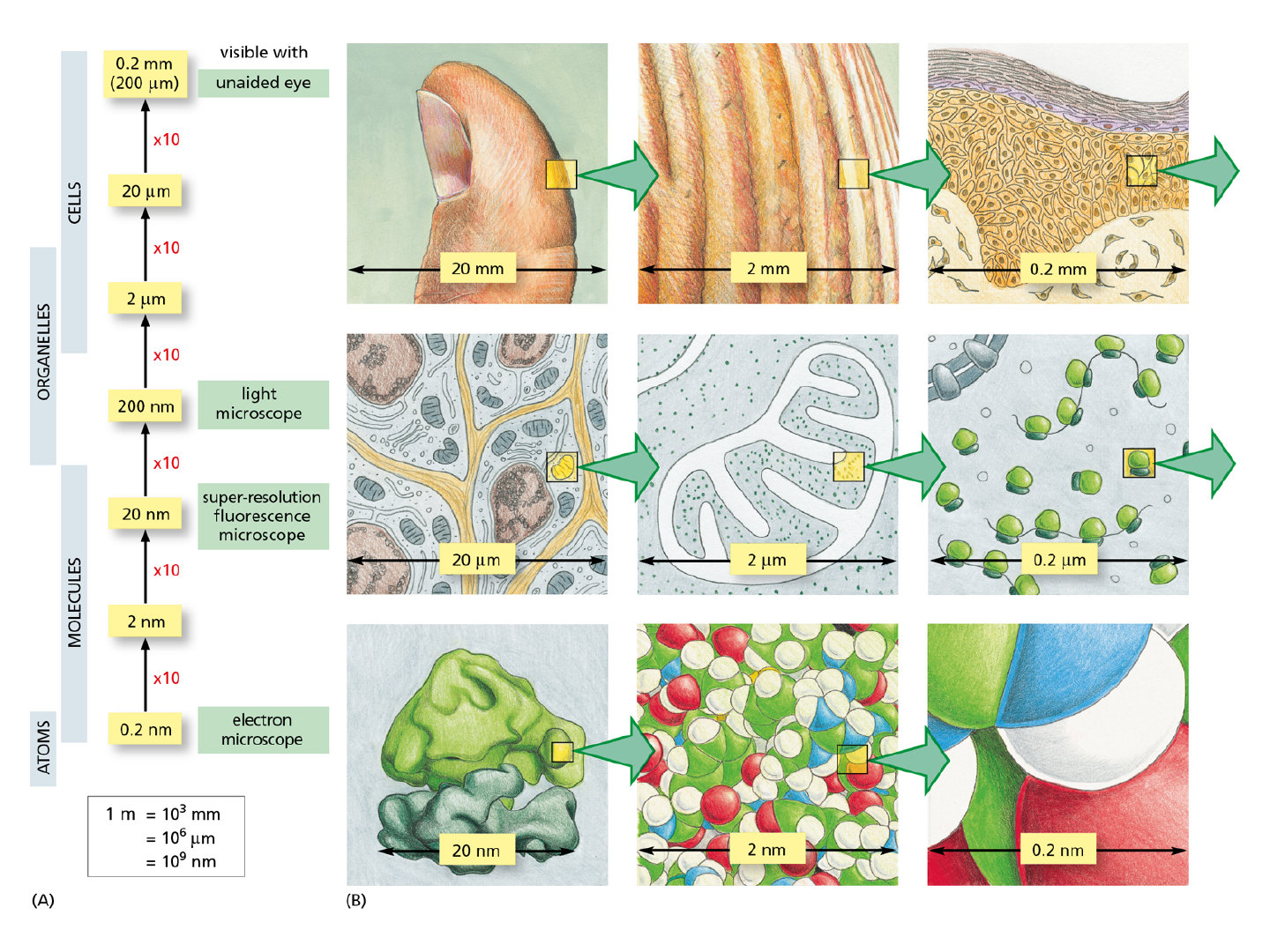Facts from Essential Cell Biology Chapter 1, Cells: The Fundamental Units of Life
| 717 words- Unity and Diversity of Cells
- Cells Under the Microscope
- The Prokaryotic Cell
- The Eukaryotic Cell
- Model Organisms
Here are facts that I found interesting from the first chapter of Essential Cell Biology.
Unity and Diversity of Cells
- Cells sizes vary from a few micrometers (Lactobacillus) to 1 millimeter (frog egg).
- Human brain nerve cells are 10,000x longer than they are thick.
- Evolution offers a compelling explanation for why all cells are so similar: they all inherited their genetic instructions from the same common ancestral cell that existed between 3.5 and 3.8 billion years ago.
- Differentiated cell types like fat, skin, bone, and nerve cells all contain identical copies of the DNA of the species. They use their genes to produce different sets of proteins based on internal state and cues that they and their ancestors received from their surroundings.
Cells Under the Microscope
- The official birth of cell biology is generally to be publications by Schleiden and Schwann in 1838/9 documenting the results of a systematic investigation of plant and animal tissues.
- Louis Pasteur refuted the theory of spontaneous generation by displaying two flasks of beef broth, boiled to eliminate organisms, one with a swan neck and one without a swan neck. The one with the swan neck didn’t become cloudy (with bacteria), while the one without did. The explanation is that the swan neck traps dust, thus preventing organisms from getting into the sterilized broth.
- The fact that cell components have different refractive indexes can be used to distinguish between components.
- Light microscopes cannot distinguish between structures smaller than about 0.2µm, about half the wavelength of visible light.
- Here is a neat chart showing the sizes of things:
- Fluorescence microscopy works by the following:
- cells are stained with fluorescent dye, which absorbs light at frequency A and emits at frequency B.
- light of A is shined on the cell.
- the dye fluoresces, sending back a combo of A + B
- light A is filtered back out, so the human only sees light B, which is the light emitted by the cell.
The Prokaryotic Cell
- Many prokaryotic cells can duplicate themselves in about 20 minutes in optimal conditions.
- Mitochondria are thought to be evolved prokaryotic cells that use oxygen (called aerobic).
The Eukaryotic Cell
- Eukaryotic cells are defined by having a nucleus, which stores DNA and is enclosed by the nuclear envelope.
- Mitochondria generate adenosine triphosphate (ATP) from food molecules.
- Chloroplasts are large green organelles found in plants and algae that generate ATP from sunlight.
- Cytosol is a concentrated aqueous gel of large and small molecules. It behaves more like a water-based gel than a liquid.
- The cytoskeleton is responsible for directed cell movements. It forms a system of ropes, girders, and motors that gives the cell its strength, shape, and ability to move.
- In-plant cells, organelles such as mitochondria are driven in a stream around the cell interior along cytoskeletal tracks.
- Motor proteins use ATP energy to move along the cytosol’s tracks and cables
- Eukaryotic cells are typically 10x the length (and thus 1000x the volume) of prokaryotic cells. One theory suggests the first eukaryotic cells fed by capturing other cells. Such a cell would have engulfed a mitochondria or chloroplast, creating modern-day eukaryotic cells.
- Biologists often study model organisms. Common model organisms are E. coli and brewer’s yeast.
Model Organisms
- Biologists often study model organisms. Common model organisms are E. coli and brewer’s yeast.
- The Cdc2 gene in some forms of yeast is required to trigger key steps in cell division. If you replace this gene with the human version (which is 63% the same), then the yeast can still divide.
- Model animals are the fruit fly, the nematode worm (which has exactly 959 body cells), and the zebrafish (which is transparent for the first two weeks of its life).
- E. coli carries genetic instructions in a single, circular double-stranded molecule of DNA. It has 4.6 million nucleotides and 4300 protein-coding genes.
- The simplest bacterium contains 500 genes. Most prokaryotes have at least 1 million nucleotide pairs and 1000-8000 genes.
- Humans have 700x more DNA than E. coli (3 billion pairs, 20k genes). Amoeba has 100x more DNA than humans.
- Vast bulk of DNA includes a mixture of sequences that help regulate gene activity and dispensible sequences.
